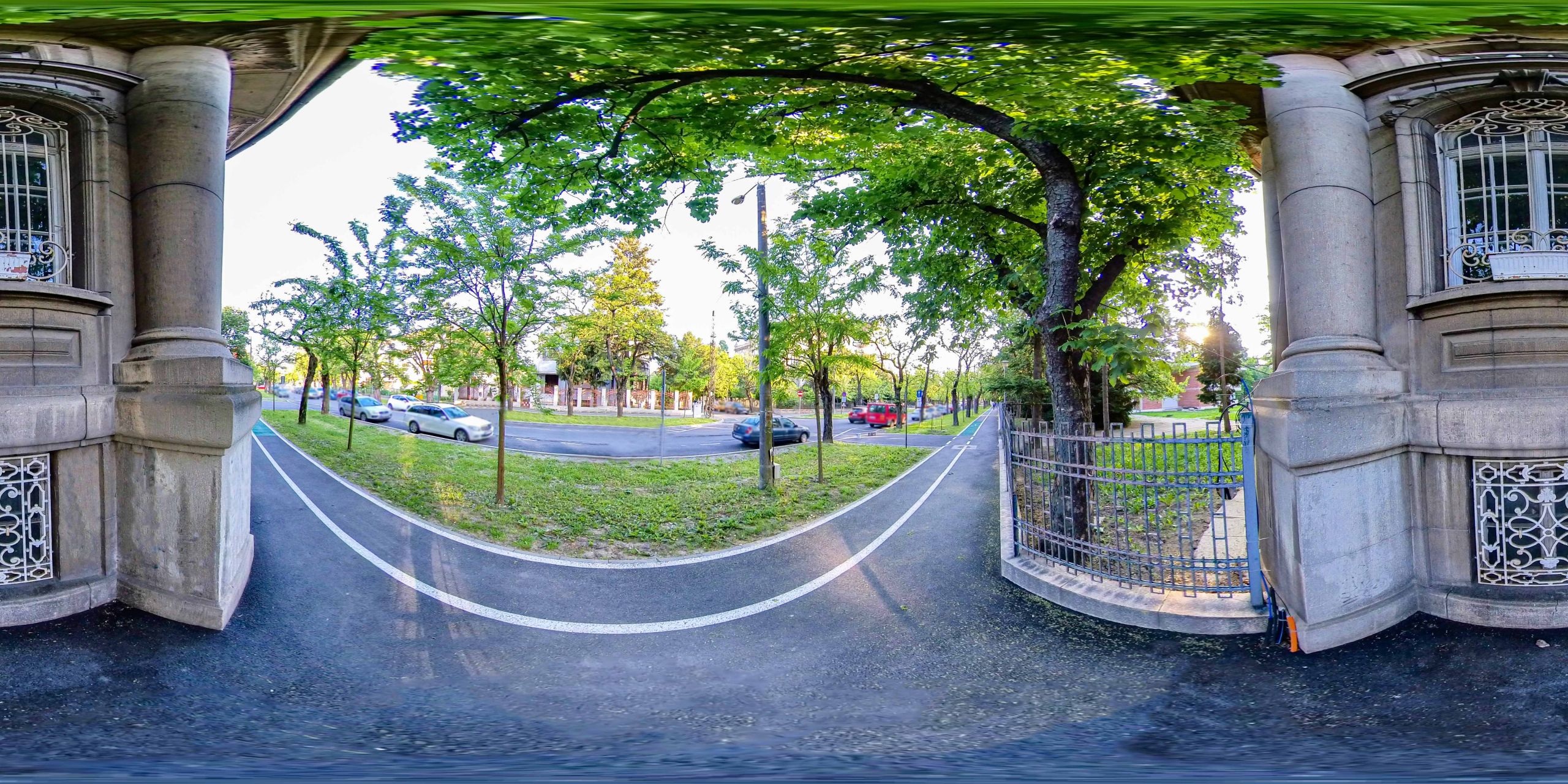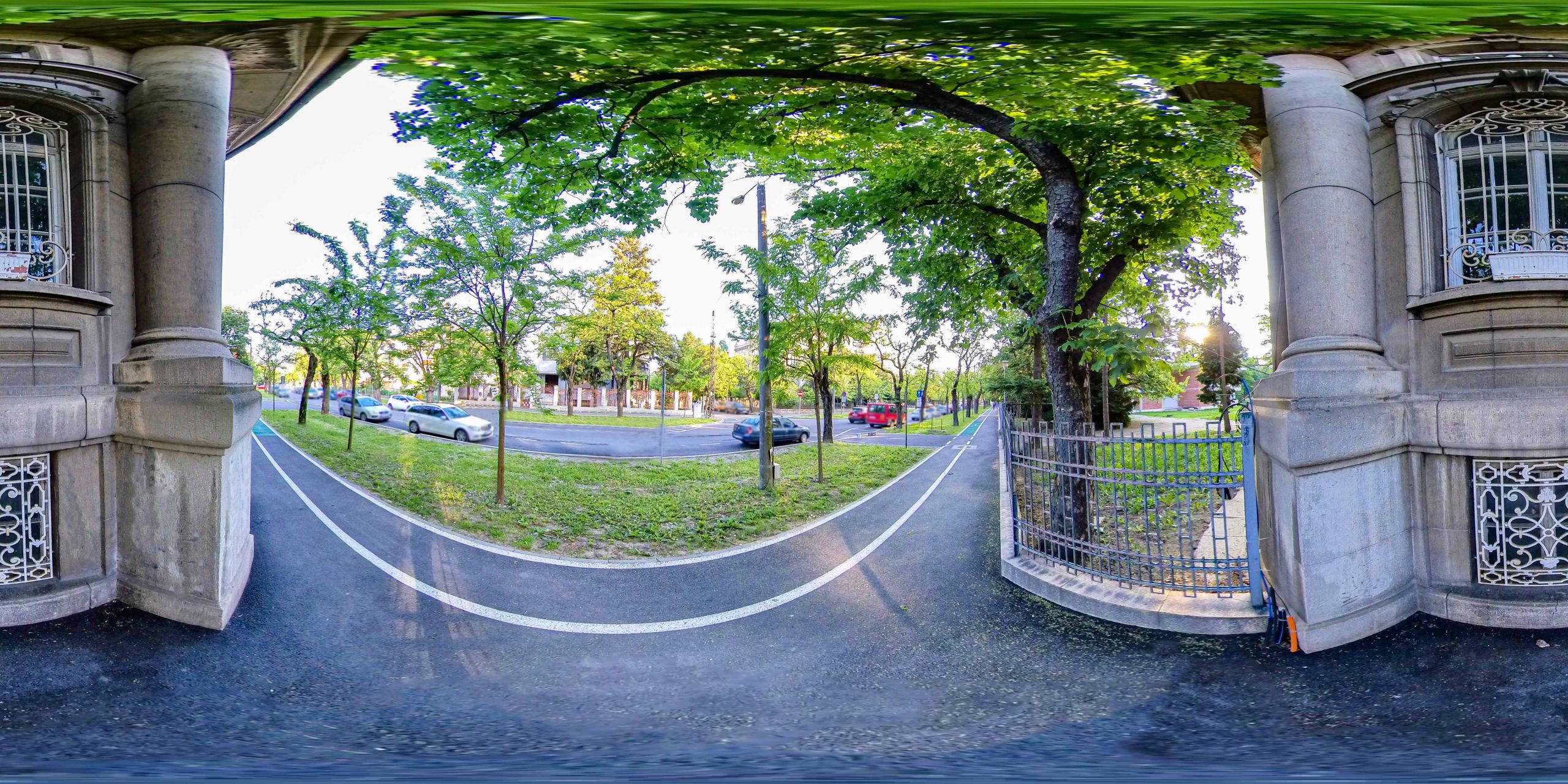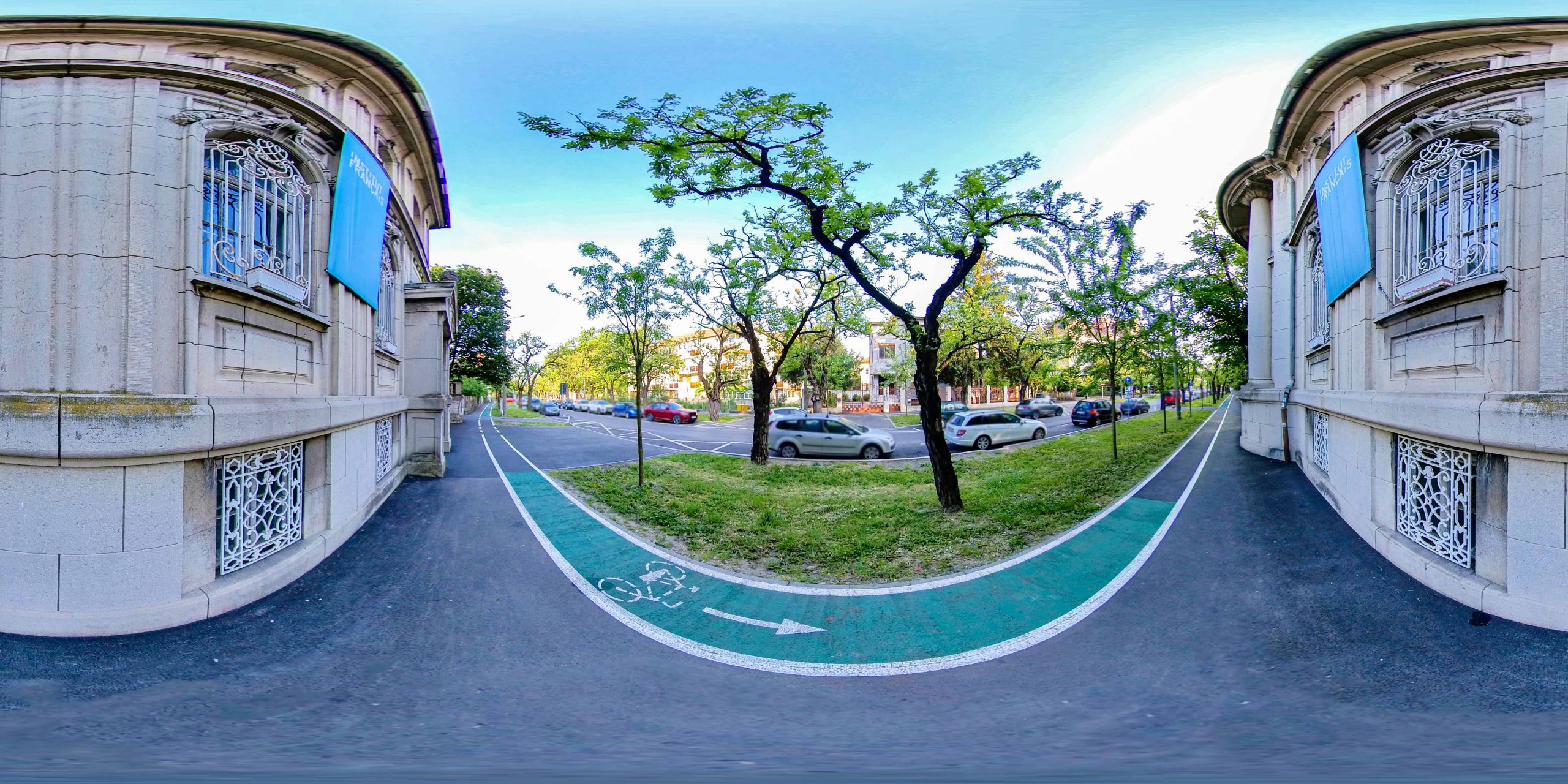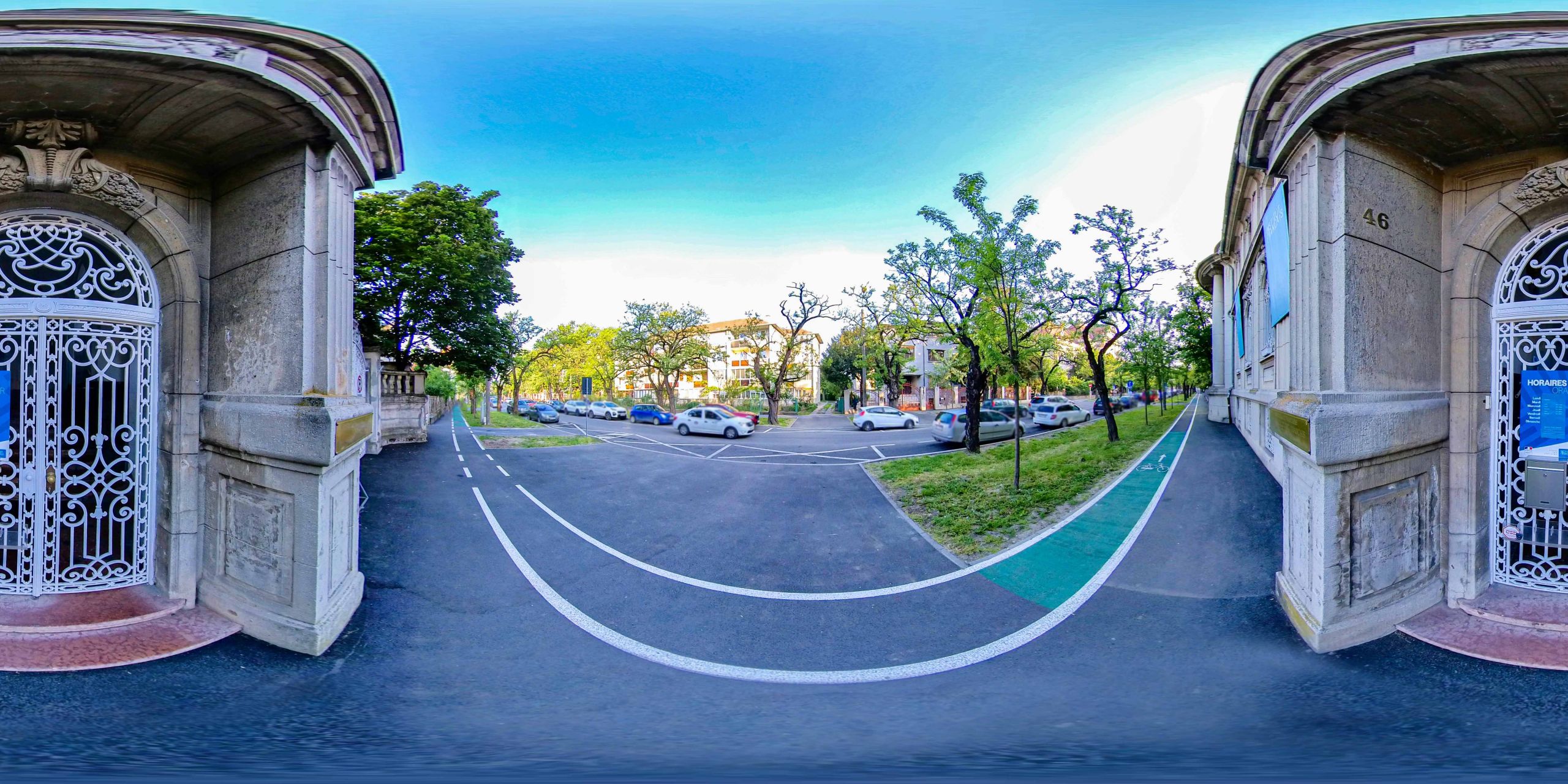Kimmel Villa was built between 1911-1914 (arch. Josef Kremmer senior and arch. Josef Kremmer junior), with an area of over 1000 square meters, being surrounded by a park.
Listen to the audio version.
Villa Kimmel (bld. Constantin Diaconovici Loga no. 46) was built between 1911-1914 (by the architects Josef Kremmer Senior and Josef Kremmer Junior) in the style of the 1900s with elements of the classic French architecture of the 18th century, being surrounded by a park, reaching as far as the river Bega. The sponsor of the building was Ignác Sándor Kimmel, owner of a famous alcohol factory for the manufacture of brandy, exported throughout the Austro-Hungarian monarchy.
In the 1930s, the building was sold to the Langer family, who emigrated to France after nationalization. The park underwent changes after World War II with the construction of the International Villa. Between 1969 and 1977, Villa Kimmel hosted the art section of the Banat Museum and in November 1977 the building became a guest house for the Ceausescu family, who, however, preferred to live in the International Villa during their visits to Timișoara.
Kimmel Villa has been the headquarters of the French Institute since 1992.
Bibliography:
- Mihai Opriș, Mihai Botescu - Historical Architecture in Timișoara, Tempus Publishing House, Timișoara, 2014
Discount Bank (Max Steiner Palace) in Union Square
Robert Șerban
a friend wanted to buy
seven or eight years ago
the house on 46 Loga Street
so he told me
street and number
I didn’t get it
I didn’t know what it was about
and I asked him briefly
how much?
two million
he had the money
I knew that
he had a lot more
but which one is it
more exactly?
I insisted
he looked at me as if I was an alien
he shook his head and pursed his lips
and disclosed to me the place where
they invented in Timișoara
the French kiss
June 2022
“In the meantime, I became a writer instead. I really got to know Sorin in the editorial office at ‘Orizont’ and, if at university we hardly ever spoke, it was there that we became friends. He lived on Lenin Street, near the former Jewish high school. Our faculty, right on the riverside. After the eight-to-ten class, I would take off in a hurry, turn on Mihai Viteazul bridge, between Capitol cinema and the park, cross Loga Boulevard, take Lenin Street, ring the bell and he’d show up dazed, mostly after some late-night party. We listened to music, talked about books, it was quiet outside, the sun was shining and he came up with the idea that I should write for ‘Orizont’.”(Livius Ciocârlie, The Sunken Bell, Cartea Românească, 1988, p. 126)
(And whose house was it originally, from whom had your father bought it?) From Kimmel. He built it in 1913. And it is a copy of a Bavarian house, that belonged to the family of Louis II, then king of Bavaria. It did cost a lot of money back then because they imported the materials from Italy. The wallpapers were made out of silk and he chose a wonderful mosaic… Anyway, he still ruined himself, not because of the house, but because of his businesses. You know, he had a really big liquor company, and that didn't go so well. And so, he was forced to sell it. (…) There is a legend that all those who lived in that house were cursed with bad luck because it was built in `13. I do not consider it bad luck for us, I am actually glad that we ran away from Romania because of the house, because, to be quite honest, I didn’t wanna live in the Ceausescu era. That made us head to France because apparently, we didn't have another house to live in. I don’t think that’s true, but anyway… He sold it to a German and then to a Jew whose wife sold it to my family. She was Hungarian, her name was Marieta, they had no children, he was a very rich Jew, he died and left her his house and belongings. Living alone in such a big house, ... it takes a lot of staff…. My mother had four girls, and two cooks because my father had this mania; - most Romanians have it- he would meet someone on the street and bring him home, and my mother would never know if we were five or fifty at the dining table. The only time my father called my mother, he called her from the factory and said, "Guess who's coming to dinner tonight!" So, around 10-11, he called her. Well, as far as I know, the prefect was still coming, and a few ministers from Bucharest were also coming, but she was not moved by any of it and he never said who was actually coming. He would say, "King Mihai is coming, he is hunting at the Green Forest, and then he will dine with us and sleep at our house." My mother went crazy. Grandma was also an extraordinary housewife, she would arrange the whole table, and make sure everything was perfect. She said to me, "Your father shouldn’t have told us the King is coming!" She was a beautiful woman anyway, always taking care of herself, especially when my father was around. She was always well-groomed, very elegant, and beautiful. She didn't need the compliments anyway, because she had been sitting in the closet all day thinking, “Should I put the black dress on? No! What about the blue dress? ... ”. And it was a huge stress, which we didn't need, my grandmother said. And so, they sent us to the other grandmother, to make room for everyone, because he was accompanied. And that was the only time my father said to her, "Just to let you know, the King is coming to us." Otherwise, many more would have come.
(Who was he in a friendship with?) Literally everyone! (What families do you remember going to more often?) They had some friends, a doctor, a lawyer - Valeriu Sârbu - he was their best friend. He was from Ticvani. He had a sister who lived much longer than him, he was a very nice man and he was not married. He was more than happy to come to eat with us anytime because he basically did not have a household and his mother stayed at her house in Ticvani. So he came almost every day. And he was very nice. And every time I went to see my grandparents, he was immediately on the spot to congratulate me and whatnot. They were married but had no children. They had a household, they had a cook, so they had a place to eat, but they still came around quite often. In fact, they were mine and my brothers' godparents. They were very nice people and they loved us. So whenever a child came around, they baptized him. (So you have another brother?) Yes, I have two brothers, there are three of us. I was going to the Greek Catholic church, which was on Baba Dochia street, but I recall it is no longer called like that. (In the Fabric?) Yes. There is a Greek Catholic church that was closed down later on, and we were baptized there. The godmother and the godfather would come to our house quite often.. (Where did they live in Timisoara?) They lived on the bank of the Bega, close to the Decebal Bridge, after the Prefecture, towards Fabric. There are perpendicular streets to the Bega, and their house was on one of these streets.
(Didn't he have Jewish friends? Industrialists?) Industrialists, no, but there were some who worked in the factory - there was a Ritter, there was a Berger... But most of them went to Israel afterwards. (So where was the factory?) It was in Fabric, also on the bank of the Bega river, and it was called "Splaiul Morarilor". (After the Turkish Prince?) I don't know exactly. Right before, after Trajan Square. It was IRP (Romanian Leather Industry), it was Weständ for gloves and it was "Ideal" - for shoes. So he bought twelve houses that were around. When he moved from Oraviţa, he wanted the workers to come as well, because he brought some people from the West, from Switzerland, France, and even Italy - who taught him how to make models. And that is a real job, not just some easy work. And they were very skilled. He could not find any workers like them in Timișoara, and in order for them to come to join him at the factory, he bought 12 houses around the factory, in order to accommodate them. And they all came with him and with their families.
Mariana Duval b. Langer, 1935 Oraviţa (daughter of the owner of the Weständ Glove Factory, the last owner of the house) interviewed by Smaranda Vultur in 2007 in Paris (personal collection, BCUT archive)
The Langer family I went to as a child used to live where we can find the French Cultural Center (the French Institute today). I remember it had this amazing interior staircase and every time I enter the French Cultural Center I feel like I can’t wait to see the splendid library inside. It had a roundabout where the toy room was and a terrace outside where they had a moving fountain with redfish inside. (...) There was also a swimming pool, where I met all these children who were of different origins - Romanians, Serbs, Jews, Italians, children of officials from these consulates, such as the Belgian consulate... There were several consulates on Loga Street. It was an extremely high society in this neighborhood, I would say some kind of "Primaverii neighborhood" of Timisoara. Loga was a quiet neighborhood, there was no traffic, there was no asphalt, there was just cobblestone and when the Russians came to invade, you could actually hear the bicycles they were using, the tires got cut.. and they were riding on the rim. (....) In our house, we had rooms that were given to Russian officers. We lived on Loga street at number 24, on a street corner.
Nicolae Diminescu . b. 1939 interviewed by Adrian Onica in 2005 Timişoara. Archive of the Group of Oral History and Cultural Anthropology Third Europe, BCUT
Witness
by Ioana Corui, class XII
"Grigore Moisil" Theoretical High School Timișoara
In the heart of Timișoara, right in the middle of the Central Park, I stand, an old lime tree that has seen many seasons pass and many generations change. My roots are deep in the soil of this city, and my branches spread wide, offering shade and shelter to passers-by. Over the decades, I have become a silent witness to the history of this wonderful place.
In the spring, when my leaves open, I can feel the life of the city coming to life. Timisoara fills with colors and sounds, and people come to stroll in the alleys of the park. I see them stop to admire the flowers, laugh and enjoy the warm sunshine. Sometimes, I hear snippets of conversations, stories about their lives, hopes and dreams.
In summer, my shade becomes a favorite refuge for those seeking coolness. I see couples yearning under my branches, exchanging glances and words of love. Sometimes they sit on the wooden bench next to me and share their dreams. Tourists come and go, fascinated by Timisoara's beauty and history, and I am a constant witness to their admiration.
In the fall, my leaves turn shades of gold and aubergine, slowly falling in the alleys. It is a season of reflection, and the city takes on a nostalgic air. I see students returning to college, carrying with them the excitement and eagerness of a new beginning. The park fills with people strolling, reflecting on the passage of time and the changes in their lives.
In winter, when the snow covers my branches and transforms the park into a fairytale landscape, I feel like a protector of silence. The Christmas lights twinkle in the distance, and I feel the joy and warmth of the holidays, even though the air is cold and harsh. People gather to celebrate together, and I am a quiet witness to these moments of unity and happiness.
Over the years, I have seen many changes in Timisoara. I have seen the city modernized, old buildings restored and new generations come and go. But through all this change, I have remained constant.
One day, when I am too old to stand, I know that my memory will live on in the hearts of those who have found shelter under my branches. Because, in essence, I am part of the soul of Timișoara, a city that lives and breathes through its people, its history and the nature that surrounds it.

















